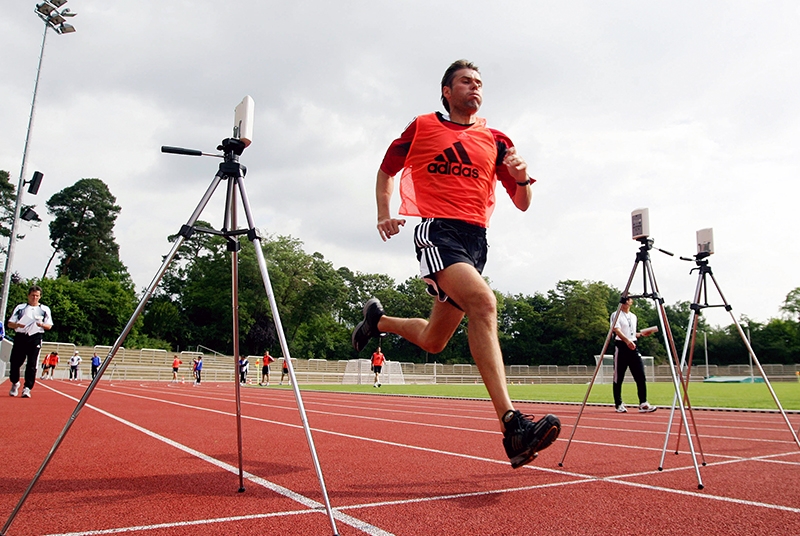You are viewing 1 of your 1 free articles. For unlimited access take a risk-free trial
Zone training: why low-tech can work too!

SPB explores the concept of training zones for endurance athletes, explains how successfully targeting your desired training zone can be achieved without reliance on high tech
Understanding the concept of training zones is vital for maximizing performance. For example, to improve the muscles’ ability to burn carbohydrate very quickly to fuel high-intensity exercise, you need train in the ‘lactate’ zone – not in a different zone! And to know how to do this, you need to know where the zone boundaries lie and how to know which zone you’re currently in. In short, if an athlete doesn’t understand training zones, knowing how hard to train and how to vary training intensity becomes nothing more than guesswork.Energy systems and training zones
Underpinning the concept of ‘training zones’ are the energy systems that power the body. Unlike a car, which has at most an engine and an electric motor, running on two types of fuel, human muscles are fuelled by four distinct energy systems, enabling the body to perform immediate, very high intensity work and also sustained lower intensity work. However, thanks to Nature’s ingenuity, these energy systems are seamlessly integrated together, which is why it’s not apparent that energy use changes as you work harder and harder. These energy systems are as follows:- Stored adenosine triphosphate (ATP) – this is an immediate source of energy that lasts for just 3-4 seconds. Although all muscular contraction uses ATP, most of this is generated in situ by the other three energy processes described below.
- Phosphocreatine (PC) system – helps bolster flagging ATP stores very rapidly by regenerating broken down ATP using donated phosphate from a reservoir of high-energy phosphate in the muscles known as creatine phosphate (this is the energy system enhanced by the food supplement creatine). The PC system provides about 10-15 seconds’ worth of energy.
- Lactate system (also known as the ‘anaerobic’ system) – takes a bit longer to kick in, but helps to regenerate ATP fairly rapidly by the incomplete breakdown of carbohydrate without oxygen. The lactate system eventually runs out of steam - not because carbohydrate is exhausted, but due an increase in acidity within the working muscles, which results in intense fatigue. Flat out, the lactate system can supply about 1-2 minute’s worth of ATP.
- Aerobic system – uses fat, carbohydrate and even protein to produce ATP. It’s the slowest system to kick in, and can’t generate ATP as rapidly, but providing there’s enough oxygen available and the athlete is fit enough, the aerobic system can provide energy for several hours!
Figure 1: Schematic representation of contribution over time of the body’s energy systems

Pink = ATP system; blue = CP system; green = lactate system; black = aerobic system.
A quick look at figure 1 shows the contribution these energy systems make to total energy demand during periods of maximum sustainable exercise. Notice how each system overlaps with the one it precedes. This is necessary for seamless integration of the systems – you wouldn’t want to stutter and hesitate during the transition from one system to another as your exercise intensity increased! So while there are discreet ‘zones’ corresponding to the different energy systems, the boundaries of these zones are rather ‘fuzzy’.
For example, a cyclist performing 20-30 second bursts of high-intensity cycling is using (and training) both the PC and lactate systems. Likewise, a hard 5-minute effort in the pool would use both the lactate and the aerobic systems. It’s also important to realize that these zone boundaries are not fixed; for example, by training the aerobic system, it can kick in earlier and supplement energy output at higher training intensities.
Hopefully, it is self explanatory that because the muscles use distinct energy systems at different levels of intensity, any training program needs to target these energy systems in a way that reflects the demands of the event the athlete will be performing. And if that event places demands on more than one energy system (it nearly always does), you’ll need to target each energy system with specific types of training.
Targeting the zone
In order to successfully target a particular training zone, an athlete needs to know two things:- What zone am I in now?
- How will I know when I transition up or down into another zone?
- Perceived effort level
- Breathing (ventilation) rate
- Heart rate
- Power output
- Blood lactate levels
Box 1: Limitations of technology
While devices such as heart rate monitors, power meters and lactate measuring can be very useful in helping you to monitor and target a certain training intensity, they still have limitations:Heart rate monitor limitations
- Formulae used to predict maximum heart rate may not be accurate for all individuals, leading to inaccuracies in zone determination.
- As fitness levels improve, heart rates at the transitions between zones may increase a little too, especially the boundary between zones 1 and 2.
- Heart rate during exercise can be affected by other factors – for example poor recovery after previous training sessions, or if you’re fighting off a virus, both of which will your elevate heart rate for any given workload.
- While power meters are available for cyclists and indoor (ergo) rowers, no such direct-measurement devices are yet available for runners and swimmers.
- Although becoming cheaper, accurate power meters for cyclists are still relatively expensive.
- As fitness levels change, sustainable power outputs for a given zone or blood lactate concentration will change considerably, which means that athletes will need to recheck power output/blood lactate concentration regularly, especially those who are a relative novices or are returning from a layoff, when quite large fitness changes can occur in a relatively short timescale.
- Lactate monitoring, which requires real-time blood sampling, cannot be used as a guide to intensity unless performed in the lab. To illustrate why, consider a cyclist riding along seeking to monitor blood lactate levels. This would require the cyclist to repeatedly stabbing him/herself in the finger at different points along the route to take a blood sample, and then to insert a test strip into a machine and await a reading. It is clear that this would be absurd!
- Because of the above, the real value of using lactate measurements is in combination with other measurements such as power, speed and heart rate. Blood lactate should therefore be seen as an adjunct rather than a prime means of targeting a zone.
Power of perception
Perceived level of effort is the easiest (and perhaps most underrated) way of knowing which zone you’re in. It doesn’t require any equipment or technology and can be used regardless of fitness level. To give you an idea of what this means in practice, take a look at table 1 below, which relates sensation of effort, blood lactate and energy system used.Table 1: Perceived effort and zone training
| Zone | Sometimes known as: | Subjective feel: | Typical blood lactate | Typical heart rate |
| 1 | ‘Aerobic’, ‘easy’, ‘recovery’, ‘long slow distance’ etc | Easy – you feel like you can keep going and going | Less than 2mmol per litre (mM/L) | Under 80% and typically around 70-75% of maximum |
| 2 | ‘Threshold training’, ‘intensive endurance’ etc | Moderately hard to hard (you know you’ve had a workout) | Between 2 and 4mmol per litre (mM/L) | Around 80-85% of maximum |
| 3 | ‘Very high intensity’, ‘race pace’ etc | Very, very hard (you won’t want to stay in this zone for long!) | More than 4mmol per litre (mM/L) | Significantly over 85% of maximum |
| Recent research suggests that for endurance athletes seeking maximum gains, zone 1 training should comprise the bulk (over 80%) of the training volume, while ensuring some time (10-15%) is set aside for zone 3 training. Zone 2 training meanwhile should not form a major part of your training volume(1). | ||||
When gauging perceived effort, researchers have found that a numbering system can be useful; not only does it help users to more accurately report effort levels, the ‘Borg’ 1-20 scale also provides an approximation to heart rates (see table 2). Relating the Borg scale to the zone system above, we would have:
- Zone 1: approximately 11-14
- Zone 2: approximately 14-17
- Zone 3: 18 and above
Table 2: Borg’s ‘Perceived Rate of Exertion’
| Scale Number | Perceived Effort Level | Approximate Heart Rate |
| 6 | Rest | 60-70 |
| 7-8 | Very, very light | 80 |
| 9-10 | Very light | 100 |
| 11-12 | Fairly light | 115 |
| 13-14 | Somewhat hard | 130 |
| 15-16 | Hard | 150 |
| 17-18 | Very hard | 160-170 |
| 19 | Very, very hard | 180 |
| 20 | Total exhaustion | Maximum heart rate |
The beauty of using perceived effort is that it’s extremely simple and costs nothing. It has also been found to correlate closely with work rate and actual oxygen consumption(2). Moreover, technophobe athletes who enjoy training without being wired up like a NASA astronaut will also appreciate the freedom from technology it allows!
Of course, it’s tempting to think that while perceived effort is good enough for amateurs, when it comes to elite or pro athletes, there’s no substitute for sophisticated technology. But this is notion is not supported by the evidence. For example, research on pro cyclists competing in 5, 7 and 21-day race has found that using perceived exertion alone is every bit as accurate as using sophisticated heart rate monitoring for measuring both riding intensity and total workload over the races(3).
One possible downside however is that the subjective nature of perceived exertion means that it may not be quite so suitable for very inexperienced athletes who are less able to gauge where they are on the intensity scale and how it relates to their performance. The good news though is that research also shows that inexperienced athletes who use it regularly very quickly learn how to get accurate perceptions of their work rate(4).
Using ventilation rate
Another very useful method that can be used to target a particular zone is ventilation (breathing) rate. Without delving too deeply into the biochemistry involved, it turns out that as exercise intensity increases, the ventilation rate follows a very similar pattern of change as that observed with blood lactate (see box 2). In other words, the rate of breathing increases with increasing exercise intensity, but not linearly. Instead, it undergoes two distinct step changes – known as ‘VT1’ and ‘VT2’ (see figure 2).Figure 2: Step changes in breathing rate during increasing exercise intensity

The relationship between lactate and ventilatory thresholds is remarkably close; figure 3 shows an overlay of typical ventilation rates and blood lactate levels during incremental exercise. Given that the first and second lactate thresholds can be used to determine the boundaries between zones 1 & 2 and 2 & 3 respectively, this close relationship means that breathing rate can also be used as a cheap, simple and non-invasive method of targeting an athlete’s preferred zone.
Figure 3: An overlay of blood lactate and ventilation rate

Red plot = lactate concentration; blue plot = ventilation rate. The 1st lactate threshold is reached in the purple area, as is VT1. The 2nd lactate threshold is reached in the red area, as is VT2.
Box 2: Understanding lactate and training zones
Measuring lactate concentration in the blood provides a direct insight into what’s actually happening biochemically in muscles, and by implication, exactly how intense the exercise is. During light exercise (zone 1), blood lactate remains at or near to resting levels (there’s always some lactate production during energy metabolism) – ie under 2mM/L.However, as exercise intensity increases, there comes a lactate concentration at which blood lactate levels rise sharply – usually around 2mM/L. This is commonly known as ‘lactate threshold’ – also sometimes referred to as ‘first lactate turn point’ and (perhaps incorrectly) as ‘aerobic/anaerobic threshold’.
While you can exercise for several hours below lactate threshold without significant fatigue, move above it and fatigue will slowly begin to accumulate, even though lactate levels themselves aren’t steadily rising. Using our zone system above, lactate threshold would mark the boundary between zones 1 and 2.
However, as exercise intensity increases further, there’s another important blood lactate reference point, which occurs shortly after lactate threshold. This is the point where there is a ‘sudden and sustained’ increase in blood lactate concentration. There are a number of terms used to describe this second point including ‘second lactate threshold’, ‘lactate turnpoint’, the ‘onset of blood lactate accumulation’ (OBLA), ‘functional threshold’ and ‘maximum lactate steady state’ (MLSS).
In terms of actual blood lactate, this second threshold occurs around 4mM/L and is characterized by a large increase in breathing rate and sense of effort, and a rapid buildup of fatigue. At this point, lactate production begins to outstrip the body’s ability to remove it.
Using our zone theory, this second threshold represents the border of zones 2 and 3. In terms of what it means, the intensity at this second lactate threshold point (or just below) is the maximum pace you will be able to sustain over a period of time – eg in a race or time trial (hence the term MLSS). Muscular fatigue will still accumulate but not so rapidly that you have to slow down or stop in the short term.
Studies on trained cyclists show that using ventilation rate to monitor intensity and target training zones can be extremely accurate, especially when combined with perceived exertion(5). And like perceived exertion, being mindful of your ventilation rate can be extremely useful even when using heart rate monitors and power meters, helping you to confirm and add context to any data you see on your monitor. Indeed, despite the explosion in technology that manufacturers tell us is absolutely essential for optimizing training, it’s quite possible to undertake extremely effective targeted zone training using only your perceived exertion and ventilation rate!
Practical advice: Combining perceived exertion and ventilation
*Using the findings outline above, we can develop a practical strategy for using ventilation rate and perceived exertion to monitor intensity. All athletes and their coaches need to know is the following:
- Below VT1 equates to zone 1 training.
- Above VT1 but below VT2 equates to zone 2 training.
- Above VT2 equates to zone 3 training.
- Below VT1 you can speak comfortably, recite the alphabet etc.
- At VT1: you can no longer speak comfortably; it requires some effort at this point
- Above VT1/below VT2, speaking is possible but not really comfortable. For example, you can’t recite the entire alphabet with ease at this point.
- At VT2 and above, speaking is no longer possible with the exception of one or two-word statements. You won’t be able to maintain this intensity for long above this point!
*We can combine this knowledge with perceived exertion, which yields the following guide:
Pure zone 1 training- Effort level – easy; you feel like you can keep going and going
- Ventilation - you can speak comfortably, recite the alphabet etc
- Effort level – sustainable but becoming a little harder
- Ventilation – speaking requires some effort at this point
- Effort level - Somewhat hard but still sustainable (for an hour or two)
- Ventilation - speaking is possible but not at all easy (you’d struggle to hold a conversation)
- Effort level – exercise starts to feel much, much harder
- Ventilation – speaking is still possible but becomes difficult to utter more than a few words
- Effort level – very hard indeed; exhaustion soon sets in!
- Ventilation - speaking is virtually impossible apart from the odd word
References
- Front Physiol. 2014 Feb 4;5:33
- J Sports Sci. 2008 Jan 15;26(2):131-9
- J Strength Cond Res. 2012 Aug;26(8):2249-57
- Int J Sports Med. 2014 May;35(5):379-84
- J Strength Cond Res. 2013 Jul;27(7):1942-9
Related Files
Newsletter Sign Up
Testimonials
Dr. Alexandra Fandetti-Robin, Back & Body Chiropractic
Elspeth Cowell MSCh DpodM SRCh HCPC reg
William Hunter, Nuffield Health
Newsletter Sign Up
Coaches Testimonials
Dr. Alexandra Fandetti-Robin, Back & Body Chiropractic
Elspeth Cowell MSCh DpodM SRCh HCPC reg
William Hunter, Nuffield Health
Keep up with latest sports science research and apply it to maximize performance
Today you have the chance to join a group of athletes, and sports coaches/trainers who all have something special in common...
They use the latest research to improve performance for themselves and their clients - both athletes and sports teams - with help from global specialists in the fields of sports science, sports medicine and sports psychology.
They do this by reading Sports Performance Bulletin, an easy-to-digest but serious-minded journal dedicated to high performance sports. SPB offers a wealth of information and insight into the latest research, in an easily-accessible and understood format, along with a wealth of practical recommendations.
*includes 3 coaching manuals
Get Inspired
All the latest techniques and approaches
Sports Performance Bulletin helps dedicated endurance athletes improve their performance. Sense-checking the latest sports science research, and sourcing evidence and case studies to support findings, Sports Performance Bulletin turns proven insights into easily digestible practical advice. Supporting athletes, coaches and professionals who wish to ensure their guidance and programmes are kept right up to date and based on credible science.













